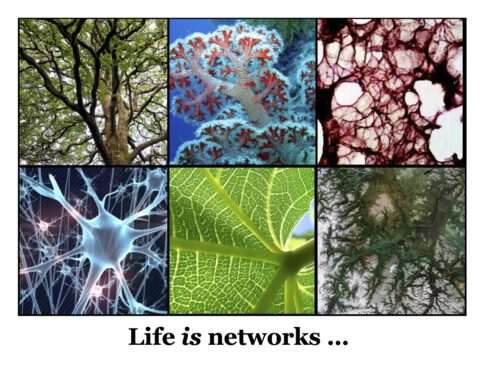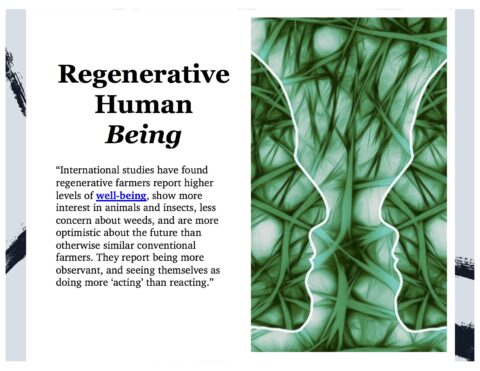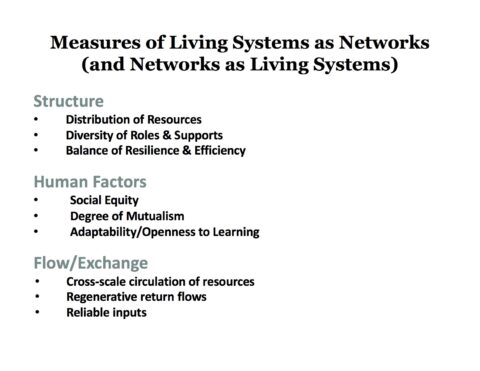Cultivating Regenerative Capacity In and Through Networks
September 18, 2020 Leave a commentA couple of months ago I was invited by Visible Network Labs to give a presentation to the Network Leadership Training Academy on regenerative networks. This was of course done virtually, and I was already wanting to not simply present or talk about the topic, but invite people into some kind of embodiment of it (given regeneration is about bringing life to life!). And so here is how I, along with a team of collaborators, invited people in …
We began with a truncated grounding practice that I received from The Weston Network/Respectful Confrontation community, which invites people to align their energetic center (gut), heart and mind, while cultivating deeper connection to self, surrounding and others. At its best, this practice boosts life force (chi) and gets energy and emotion flowing within and between people. Indications from the Zoom chat afterwards were that a number of people were indeed “rejuvenated” by the practice.
Then we showed a video for the song “The Play” by Minnesota-based singer songwriter Peter Mayer. The imagery is very evocative of the grandeur of life and the lyrics invite the listener/watcher to consider their role as both observer of and participant in this amazing show of creation and evolution. What do you feel moving for you as you take this in? See below:
Then we moved on to a group read (by the diverse, ad hoc and spontaneously named Regenerative Network Players) of a number of quotes that connect to these themes of networks, life, flow and evolution. People were then invited into trios to meet one another and share what caught their attention in one or more of these quotes and why. Inviting you to do the same:
“We are the living conduit to all life. When we contemplate the vastness of the interwoven network that we are tied to, our individual threads of life seem far less fragile.” – Sherri Mitchell (Weh’na Ha’mu’ Kwasset, “She Who Brings Light,” Penobscot lawyer and activist, author of Sacred Instructions)
“Life did not take over the planet by combat, but by networking.” – Lynn Margulis (evolutionary theorist, biologist, science author, educator, and science popularizer)
“You’ve got to keep asserting the complexity and the originality of life, and the multiplicity of it, and the facets of it. This is about being a complex human being in the world.” – Toni Morrison
“We must create civilization(s) for equitable human wellbeing within a healthy biosphere. Since our thinking produced self-inflicted existential threats, the main challenge is to find a practical way to reconcile our thinking with the logic of life.” – all-women Emerging New Civilization(s) panel. United Nations
“The basic pattern of organization of a living system is the network. Ecosystems are understood in terms of food webs, i.e. networks of organisms; organisms are networks of cells, and cells are networks of molecules. More precisely, a living system is a self-generating network within a boundary of its own making. Each component of the network helps to transform and replace other components, and thus the entire network continually creates, or recreates, itself.” – Fritjof Capra (scientist, educator, activist)
“Ultimately there is no independent heroic ego, only the collective work of sustaining and evolving life by reshaping the relationships between the community and its larger context.” – Carol Sanford (thought leader, regenerative “resource,” author)
“As we learn to become better observers of our aliveness, we can more fully participate in our evolution as human beings and generate sustainable action or change that is aligned with what we care about.” – Eunice Aquilina (somatic and leadership coach, author)
“Seeing energy flows so that we can engage with them in positive ways is not some mystical, esoteric art, but the role of engaged human beings.” – Joel Glanzberg
“Look well to the growing edge. All around us worlds are dying and new worlds are being born; all around us life is dying and life is being born. The fruit ripens on the tree, the roots are silently at work in the darkness of the earth against a time when there shall be new leaves, fresh blossoms, green fruit. Such is the growing edge.” – Dr. Rev. Howard Thurman (author, philosopher, theologian, educator, and civil rights leader)
From there, we moved into a brief presentation on regenerative networks, with some of the following points:
- Networks are the underlying structure of life.
- That said, there is sometimes not much life or liveliness in our human networks, and sometimes they can even become deadly.
- We might think of many of the problems we face in this world as being linked to the difference (as Gregory Bateson once put it) between the way humans think and the way the rest of nature works.
- A key going forward is getting back in right relationship with the rest of life, and to align with the processes of regeneration.
- Regeneration points us to the self-feeding, self-renewing processes that living systems (including us) use to nourish their capacity to thrive for long periods of time, as well as their ability to adapt to unexpected, sometimes threatening, circumstances …
- Long-term human thriving is rooted in large part in healthy socio-ecological webs that are diverse, intricate and dynamic.
So, we then asked, how do we get back in right relationship with the rest of life, including one another, and our role as stewards in and through our networks? The answers to this question are found in the teachers who are literally all around us, in the form of indigenous wisdom and practice, the writings of the likes of adrienne maree brown, Tyson Yunkaporta, Joel Glanzberg, Carol Sanford, Daniel Christian Wahl, and Sally J. Goerner, and in the living world.
We also talked about how stories can help point us in the right directions, including a growing number of cases of the practices of ecosystem restoration and regenerative agriculture (see below).
–
“What do these stories inspire in our thinking about how we might live and practice in our human networks?” we asked.
And amidst these stories of regenerative practice taking root and growing in different places, we also looked at how these approaches have impacted individual human beings, their life and liveliness. For example, research shows the following:
With the hope and and excitement that these kinds of revelations generate, we then presented a set of measures and design features that might help cultivate greater regenerative potential in and through people’s networks, with some time to discuss what most resonated:
There was not nearly enough time to process all of this very deeply, or to look at a list of network cultivation practices we had at the ready, but we did hear growing curiosity about what it would mean to intentionally focus on developing regenerative potential at the individual, group and larger systemic levels in a variety of contexts, which has expressed itself in follow-up emails and conversations.
Hoping the same will be the case here, if you feel so inspired. What’s moving for you now?


